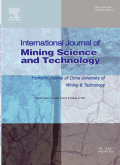- 钛学术文献服务平台 \
- 学术期刊 \
- 工业技术期刊 \
- 大学学报期刊 \
- 矿业科学技术学报(英文版)期刊 \
LiDAR mapping of ground damage in a heading re-orientation case study
LiDAR mapping of ground damage in a heading re-orientation case study
基本信息来源于合作网站,原文需代理用户跳转至来源网站获取
摘要:
The Subtropolis Mine is a room-and-pillar mine extracting the Vanport limestone near Petersburg, Ohio, U.S. In February of 2018, mine management began implementing a heading re-orientation to better con-trol the negative effects of excessive levels of horizontal stress. The conditions in the headings improved, but as expected, stress-related damage concentrated within crosscuts. The mine operator has worked to lessen the impact of the instabilities in the outby crosscuts by implementing several engineering controls. With the implementation of each control, conditions were monitored and analyzed using observational and measurement techniques including 3D LiDAR surveys. Since the heading re-orientation, several 3D LiDAR surveys have been conducted and analyzed by researchers from the National Institute for Occupational Safety and Health (NIOSH). This study examines (1) the characteristics of each 3D LiDAR survey, (2) the change in the detailed strata conditions in response to stress concentrations, and (3) the change detection techniques between 3D LiDAR surveys to assess entry stability. Ultimately, the 3D LiDAR surveys proved to be a useful tool for characterizing ground instability and assessing the effec-tiveness of the engineering controls used in the heading re-orientation at the Subtropolis Mine.

推荐文章
Elemental characteristics and paleoenvironment reconstruction: a case study of the Triassic lacustri
Trace elements
Occurrence mode
Paleoenvironment
Zhangjiatan oil shale
Yanchang Formation
Ordos Basin
Iron isotope fractionation during fenitization: a case study of carbonatite dykes from Bayan Obo, In
Iron isotopes
Fenitization
Fluid exsolution
Carbonatite
Bayan Obo
Effects of carbon anhydrase on utilization of bicarbonate in microalgae: a case study in Lake Hongfe
Microalgae
Carbonic anhydrase
Stable carbon isotope
Inorganic carbon utilization
Optimizing the ratio of the spike to sample for isotope dilution analysis: a case study with seleniu
Isotope dilution method
Error propagation
Mento Carlo
Se concentration
Geological reference materials
内容分析
关键词云
关键词热度
相关文献总数
(/次)
(/年)
文献信息
| 篇名 | LiDAR mapping of ground damage in a heading re-orientation case study | ||
| 来源期刊 | 矿业科学技术学报(英文版) | 学科 | |
| 关键词 | |||
| 年,卷(期) | 2021,(1) | 所属期刊栏目 | |
| 研究方向 | 页码范围 | 67-74 | |
| 页数 | 8页 | 分类号 | |
| 字数 | 语种 | 英文 | |
| DOI | |||
五维指标
引文网络
引文网络
二级参考文献 (0)
共引文献 (0)
参考文献 (2)
节点文献
引证文献 (0)
同被引文献 (0)
二级引证文献 (0)
2016(2)
- 参考文献(2)
- 二级参考文献(0)
2021(0)
- 参考文献(0)
- 二级参考文献(0)
- 引证文献(0)
- 二级引证文献(0)
引文网络交叉学科
相关学者/机构
期刊影响力
矿业科学技术学报(英文版)
主办单位:
中国矿业大学
出版周期:
双月刊
ISSN:
2095-2686
CN:
32-1827/TD
开本:
出版地:
江苏省徐州市中国矿业大学内
邮发代号:
创刊时间:
语种:
eng
出版文献量(篇)
2485
总下载数(次)
0
总被引数(次)
17133
期刊文献
相关文献
推荐文献
- 期刊分类
- 期刊(年)
- 期刊(期)
- 期刊推荐
一般工业技术
交通运输
军事科技
冶金工业
动力工程
化学工业
原子能技术
大学学报
建筑科学
无线电电子学与电信技术
机械与仪表工业
水利工程
环境科学与安全科学
电工技术
石油与天然气工业
矿业工程
自动化技术与计算机技术
航空航天
轻工业与手工业
金属学与金属工艺
矿业科学技术学报(英文版)2022
矿业科学技术学报(英文版)2021
矿业科学技术学报(英文版)2020
矿业科学技术学报(英文版)2019
矿业科学技术学报(英文版)2018
矿业科学技术学报(英文版)2017
矿业科学技术学报(英文版)2016
矿业科学技术学报(英文版)2015
矿业科学技术学报(英文版)2014
矿业科学技术学报(英文版)2013
矿业科学技术学报(英文版)2012
矿业科学技术学报(英文版)2011
矿业科学技术学报(英文版)2010
矿业科学技术学报(英文版)2009
矿业科学技术学报(英文版)2008
矿业科学技术学报(英文版)2007
矿业科学技术学报(英文版)2006
矿业科学技术学报(英文版)2005
矿业科学技术学报(英文版)2004
矿业科学技术学报(英文版)2003
矿业科学技术学报(英文版)2002
矿业科学技术学报(英文版)2001

 免费查重
免费查重










